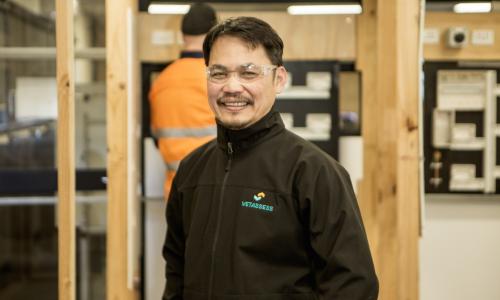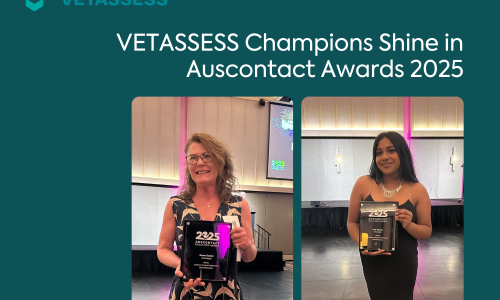Australia is planning to reopen its borders as it transitions to living with the COVID-19 pandemic and it really does begin to feel as if we are on the road back towards welcoming more skilled migrants.
At VETASSESS we're expecting a strong increase in applications for skills assessment and we are gearing up for more applications in 2022.
Australia has historically been an attractive destination for global talent, but the competition internationally is strong. COVID-19 has made it even more so.
How to fill skills shortages
Australia is not the only country with skills shortages, we're among many trying to attract talented migrants as their economies grow.
Competitor destinations are acting with foresight to adopt migration policies and practices intended to increase their appeal to students and skilled workers.
They're sending out clear signals about what they are offering and when migrants can come.
Students and talented workers do 'shop around' to see not only where they can apply their talents, but how likely they are to have their application accepted.
Migration is a life-changing venture for many people. It's often a family decision and influenced by friends and acquaintances living abroad and commentary on social media.
How can Australia get the people it needs?
The current and now persistent skills shortage has, I hope, finally debunked the notion that migrants take local jobs. Not only our regions, but also city employers, are finding it hard to hire the workers they need.
I'm among many who believe the current migration structure is underweight on attracting migrants who add to the nation's human capital over the medium to longer term.
To rebalance the program, VETASSESS has argued that all prospective skilled migrants should be subject to a skills assessment regardless of the visa scheme applicable.
At a minimum this means that they're verified to meet threshold requirements. We also want to see points-tested pathways once again take precedence within the skilled migrant mix.
Priority occupations for migration to Australia
VETASSESS has welcomed more occupations being added to the Priority Migration Skilled Occupation List (PMSOL) and we want to see the National Skills Commission assess more occupations for the PMSOL.
The list has prioritised health care occupations for the health crisis, but other occupations will be critical to positioning the nation for growth.
Every day when I pick up the newspaper, I see industries saying they lack thousands of workers, across both trades and professional occupations and both in cities and the regions. We recently saw 25 of our top tech companies form The Technology Council of Australia. They estimate the sector employs 860,000 people. The Council is advocating for skilled migration, as well as reskilling and upskilling, to fill its skills shortage.
It's our view that there are too many pathways in the migration program, serving too many objectives.
Attracting migrants to regional Australia
Regionally focused pathways and eligibility criteria can be dispensed with. Rather than 'push' prospective migrants towards the regions it would be better to 'pull' them by informing and supporting their choices.
The regions are growing because Australians are choosing to leave cities and work remotely from places where the housing is cheaper and they consider there's a better lifestyle.
That's likely to create more demand for skilled workers as regional populations grow and why shouldn't the attractions of the regions appeal to migrants?
VETASSESS assesses DAMAs, or Designated Area Migration Agreements, and industry labour agreements such as the HILA, the Horticulture Industry Labour Agreement.
DAMAs allow regional areas to hire skilled workers when they cannot get local staff and means they can hire a broader range of overseas workers than is available through the standard skilled visa programs.
DAMAs and HILAs can provide more opportunities for people who are prepared to live outside the state capital cities.
Welcoming back international students
There are moves underway to bring back international students. It's clear that many want an in-country experience rather than online learning from their home country.
The students are important not only to schools, universities and TAFEs, many decide to stay in Australia on graduating, for further study and to work.
In 2019-2020, 10,000 permanent residency skilled visas were granted to international students.
Another 63,000 temporary graduate, or 485, visas were issued for people wanting to do post-graduate study or to work.
Many of those might decide to apply for permanent residency while others will gain work experience here and later take that home or to a third country.
Australia benefits and the students add to the global capital of skilled people.
The review of ANZSCO occupation lists
We welcome the review of the Australian and New Zealand Standard Classification of Occupations (ANZSCO) while recognising that it is getting harder to keep the lists up to date.
A pragmatic solution is to add more NEC (not elsewhere classified) occupations to the skilled lists.
Another suggestion is to focus more on skills. Employers want people who are agile and have transferrable skills, who can learn, problem solve and show initiative.
The most common qualification for a skilled migrant is a bachelor degree but the labour market will benefit from shorter form and alternative credentials being recognised.
These complement traditional education and are sought and exchanged by learners, institutions, and employers everywhere.
They enable people to keep their qualifications up to date and to learn new skills. The nation's human capital benefits.
Integrity Checking migration applications
As an assessing authority for the largest number of occupations under our scope, we take pride in the integrity and rigour we apply to our skills assessment process.
Every skills assessment application will go through a basic check, such as establishing the online presence of the business and work profiles of the candidates.
This is escalated to telephone checks with referees and/or candidates.
Our assessors will ask candidates to answer generic and technical questions, which are developed in consultation with our industry partners.
In a few cases we will refer some employment claims for site visits. Currently we have capacity to do these in India, China, Pakistan and soon in Iran.
Our main aim for doing these checks is to promote confidence of all stakeholders involved in a positive skills assessment that we issue.
It's also to ensure that applicants going through the skilled migration process via our assessment pathways can transition to a successful career outcome in Australia post-migration.
The Occupation Descriptors available on our website detail the expectations in terms of qualification and employment skills and the interview process simply intends to validate those skills.
Verifying Chinese credentials
We also offer Chinese credentials verification, through an agreement with CHESSIC, the Chinese Ministry of Education's designated tertiary education verification authority.
We do this for skilled migration outcomes and for professional memberships or industry registrations.
How VETASSESS is responding to COVID challenges for applicants
We recognise there are some practical issues for applicants in trying to meet our requirements for skills assessments.
People can't get documents from an employer that has shut down or from a university that has closed.
We're all experiencing delays - whether it's getting documents or buying something we want - and this looks like being a feature of the COVID-normal world.
Our response has been to give applicants extra time to get documents or to provide a declaration, say from their solicitor or accountant, about the work they have done.
Working with industry bodies on assessment criteria
We are continually working with industry peak bodies to update our assessment criteria to ensure these are relevant to Australian industry. In October 2021 we changed our criteria for dancers and choreographers, who now need a diploma instead of a degree.
We worked on this with Ausdance, the peak body for the dance sector in Australia, and with the Department of Education, Skills and Employment, before making the changes.
The new criteria reflect occupational standards needed for employment in Australia and I hope will help more talented dancers and choreographers gain a successful assessment.
We're working with the Australian HR Institute to further develop skills assessments for the human resources sector.
As a Fellow of AHRI myself, I can see this enhancing the ability of giving qualified professionals the opportunity to bring their skills to Australia.
Like many of the occupations we assess, the international movement of people means skills are transferred and industry knowledge is improved.
Digital badges for skills assessment
We have worked with the Australian Marketing Institute to design digital badges for marketing professionals who apply to us for a skills assessment for migration purposes.
The badges are available for the occupations of Advertising Specialist, Market Research Analyst and Marketing Specialist.
They've been a hit, with marketing professionals sharing the badges to their professional sites, such as LinkedIn,
We're also working with the AMI on micro-credentials and membership assessments and talking to other industry bodies about similar arrangements for their members.
Bringing skilled workers from India to Australia
While the borders have been closed we have been working closely, with the support of our New Delhi team, with the National Skill Development Corporation of India (NSDC) to help Indian workers to come to Australia to fill skills shortages. The NSDC is part of the Federal Ministry of Education and Entrepreneurship in India.
We have signed an agreement with the NSDC to develop opportunities to enable this to happen.
The types of occupation in demand are fitters, diesel motor mechanics, truck drivers, metal fabricators and chefs.
We also expect to launch a pilot program under the Horticulture Industry Labour Agreement (HILA) to enable Australian employers to sponsor skilled and semi-skilled workers for the horticulture industry, where they can't get appropriately qualified Australian workers.
The NSDC, in collaboration with the Agriculture Skill Council of India (ASCI), will identify organisations that can help find workers for the five job roles in the pilot:
- Production Horticulturalist
- Mobile Plant Operator
- Machinery Manager
- Production Horticulture Supervisor
- Irrigationist
Some Indian training organisations may provide extra training as well as English language training, while a migration agency here is liaising with Australian employers to gather their requirements.
VETASSESS will conduct independent skills assessments for the candidates from India.
The horticulture pilot has been delayed by COVID in both India and Australia, but everyone involved is committed to making it work as soon as we can.
Horticulture accounts for around 17 per cent of the value of all rural production in Australia.
Exports are rising strongly, and the industry's people shortages have been well publicised.
A custom Skills Assessment Support service for migration agents
A few months ago, we split our Skills Assessment Support (SAS) service into an offering for individuals and a custom service for migration agents and lawyers.
This recognises agents' and lawyers' expertise in the industry and that we can often discuss their client's options in more depth than if we were speaking to an individual who is not a lawyer or a registered agent.
It's been good to see the take-up from agents and that they are building SAS consultations into their offering.
This gives agents and applicants peace of mind in preparing an application and can assist agents to manage clients' expectations.
Australia's borders reopening for migration
In summary, VETASSESS expects to see a strong increase in skills applications once Australia's borders reopen.
Australia's migrant population has played an important part in the nation's prosperity and growth, particularly following the shift in recent decades to prioritise global talent. While interrupted by a global pandemic, migration can again be an engine to economic prosperity.
We've had nearly two years of border closures to see the impact when skilled migration is stopped, and we've seen that Australia is not alone in finding it doesn't have the people it needs.
The war for talent is global and if we want to attract talented people the time to act is now.
by Rob Thomason
Rob Thomason is Executive Director of VETASSESS. This blog is based on comments he made to the Migration Institute of Australia in October 2021.
About VETASSESS
For more than 25 years VETASSESS has provided tailored, independent assessment services to governments, education sectors and industries globally.
We have pioneered assessment services to recognise and verify individuals’ qualifications, skills and experience for migration purposes against the requirements of 341 professional and 27 trade occupations.



